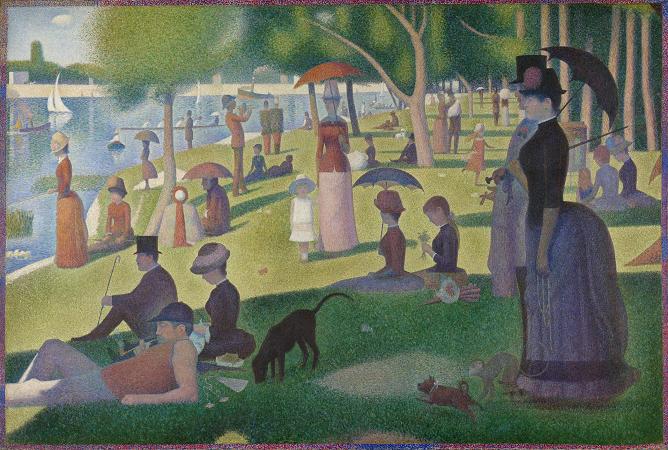Post-Impressionism Painting. Post-Impressionism is a predominantly French art movement that developed roughly between 1886 and 1905, from the last Impressionist exhibition to the birth of Fauvism. Post-Impressionism emerged as a reaction against Impressionists' concern for the naturalistic depiction of light and colour. Due to its broad emphasis on abstract qualities or symbolic content, Post-Impressionism encompasses Les Nabis Neo-Impressionism, Symbolism, Cloisonnism, Pont-Aven School, and Synthetism, along with some later Impressionists' work. The movement was led by Paul CÚzanne, Paul Gauguin, Vincent van Gogh, and Georges Seurat. The term Post-Impressionism was first used by art critic Roger Fry in 1906. Critic Frank Rutter in a review of the Salon d'Automne published in Art News, 15 October 1910, described Othon Friesz as a post-impressionist leader; there was also an advert for the show The Post-Impressionists of France. Three weeks later, Roger Fry used the term again when he organized the 1910 exhibition, Manet and the Post-Impressionists, defining it as the development of French art since Manet. Post-Impressionists extended Impressionism while rejecting its limitations: they continued using vivid colours, often thick application of paint, and real-life subject matter, but were more inclined to emphasize geometric forms, distort form for expressive effect, and use unnatural or arbitrary colour. The Post-Impressionists were dissatisfied with what they felt was the triviality of subject matter and the loss of structure in Impressionist paintings, though they did not agree on the way forward. Georges Seurat and his followers concerned themselves with Pointillism, the systematic use of tiny dots of colour. Paul CÚzanne set out to restore a sense of order and structure to painting, to make of Impressionism something solid and durable, like the art of the museums. He achieved this by reducing objects to their basic shapes while retaining the saturated colours of Impressionism. The Impressionist Camille Pissarro experimented with Neo-Impressionist ideas between the mid-1880s and the early 1890s. Discontented with what he referred to as romantic Impressionism, he investigated Pointillism, which he called scientific Impressionism, before returning to a purer Impressionism in the last decade of his life. Vincent van Gogh used colour and vibrant swirling brush strokes to convey his feelings and his state of mind. Although they often exhibited together, Post-Impressionist artists were not in agreement concerning a cohesive movement. Yet, the abstract concerns of harmony and structural arrangement, in the work of all these artists, took precedence over naturalism. Artists such as Seurat adopted a meticulously scientific approach to colour and composition. Younger painters during the early 20th century worked in geographically disparate regions and in various stylistic categories, such as Fauvism and Cubism, breaking from Post-Impressionism. The term was used in 1906, and again in 1910 by Roger Fry in the title of an exhibition of modern French painters: Manet and the Post-Impressionists, organized by Fry for the Grafton Galleries in London. Three weeks before Fry's show, art critic Frank Rutter had put the term Post-Impressionist in print in Art News of 15 October 1910, during a review of the Salon d'Automne, where he described Othon Friesz as a post-impressionist leader; there was also an advert in the journal for the show The Post-Impressionists of France. Most of the artists in Fry's exhibition were younger than the Impressionists. Fry later explained: For purposes of convenience, it was necessary to give these artists a name, and I chose, as being the vaguest and most non-committal, the name of Post-Impressionism. This merely stated their position in time relatively to the Impressionist movement. John Rewald limited the scope to the years between 1886 and 1892 in his pioneering publication on Post-Impressionism: From Van Gogh to Gauguin. Rewald considered this a continuation of his 1946 study, History of Impressionism, and pointed out that a subsequent volume dedicated to the second half of the post-impressionist period: Post-Impressionism: From Gauguin to Matisse, was to follow. This volume would extend the period covered to other artistic movements derived from Impressionism, though confined to the late 19th and early 20th centuries. Rewald focused on such outstanding early Post-Impressionists active in France as van Gogh, Gauguin, Seurat, and Redon.
more...













